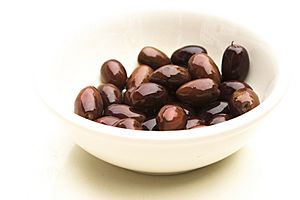Kalamata olive facts for kids
Quick facts for kids Kalamata |
|
|---|---|

A bowl of Kalamata olives
|
|
| Olive (Olea europaea) | |
| Color of the ripe fruit | Dark purple |
| Origin | Greece |
| Notable regions | Kalamata |
| Hazards | Verticillium wilt and cold |
| Use | Table and oil |
| Oil content | 6.8% |
| Symmetry | Slightly asymmetrical |
| Nutritional value per 100 g (3.5 oz) | |
|---|---|
| Energy | 284 kJ (68 kcal) |
|
3g
|
|
|
6.8g
|
|
|
Protein
|
0g
|
|
Source:
|
|
| †Percentages estimated using US recommendations for adults. | |
The Kalamata olive is a large, dark purple olive that feels smooth and meaty. It gets its name from the city of Kalamata in southern Peloponnese, Greece, where it first grew. People often eat these olives at the table. They are usually kept fresh in wine vinegar or olive oil.
The name "Kalamata" usually means olives grown in a special area of Greece. However, some countries outside the United States and European Union use the name for these olives grown anywhere. In the European Union (EU) and other countries with similar rules, the name is protected. This means only olives (and olive oil) from the Kalamata region can be called "Kalamata." Olives of the same type grown elsewhere are called Kalamon olives in the EU.
What Are Kalamata Olives?
Kalamata olives are named after the area around Kalamata, including Messenia and Laconia in Greece. Today, they are grown in many places worldwide, like the United States and Australia. These olives are shaped like almonds, plump, and dark purple.
The Kalamata olive tree is special because its leaves are twice as big as other olive trees. These trees don't like cold weather and can get a plant disease called Verticillium wilt. However, they are strong against other problems like olive knot and the olive fruit fly.
Kalamata olives cannot be picked when they are green. They must be picked by hand to avoid bruising them.
How Kalamata Olives Are Prepared
There are two main ways to prepare Kalamata olives: the "long" method and the "short" method. Both methods help remove the bitter taste from the olives.
The short method involves soaking the olives in water or a weak brine (salty water). The water is changed every day for about a week. After the bitterness is gone, the olives are put into brine and wine vinegar. A layer of olive oil and lemon slices is often added on top. Sometimes, the olives are cut to make this process faster.
The long method takes longer, up to three months. For this method, the olives are cut and placed in strong brine to remove their bitterness. Even after processing, some natural plant compounds called polyphenols remain in the olives. This is what gives them their slightly bitter taste that many people enjoy.
Gallery
See also
In Spanish: Aceituna kalamata para niños




